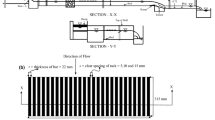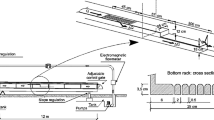Abstract
When the water has to be diverted from a turbid source having a great amount of suspended materials in it, bottom intake structures such as Coanda and Tyrolean types are preferred. To perform this task, diverted water is captured by a transversal rack, and a gallery located in the control crest is utilized. This study was motivated by a search for the best design where the quality of the diverted water can be increased by screening out most of the sediments in the flow. Current work focuses on the water capture and sediment release efficiencies of both Tyrolean and Coanda type intakes through experimental work. It complements and extends existing experimental studies by considering sediment-laden flow. We used a novel sediment feeding system designed specifically for this study in the experiments. Study results pointed out that when sediment release efficiency is considered, all types of Coanda intakes having different design parameters performed better as compared to Tyrolean intakes. Water capture and sediment release efficiencies are related to parameters used in the experiments including Coanda type, rack angle, void ratio, sediment amount, and flow rate based on the statistical analyses of these parameters. An optimum design is proposed with the maximum sediment release efficiency to prevent clogging during the operation of the intakes.
Similar content being viewed by others
Abbreviations
- a :
-
Distance between centerline of the two consecutive bars
- A, B, C, D, E, F, G:
-
Coefficients of regression analysis
- C c :
-
Coefficient of curvature
- C q :
-
Discharge coefficient
- C w :
-
The weir coefficient (= 0,635)
- d 10, d 30, d 50, d 60 :
-
Percent of the particles
- e :
-
Gap distance between two consecutive bars
- Fr :
-
Froude number
- Fr e :
-
Froude number based on bar opening
- Fr R :
-
Froude number based on curvature radius
- g :
-
Gravity
- h 0 :
-
Height of water measured in vertical direction
- L :
-
Screen length
- m :
-
Void ratio
- Q d i verted :
-
Diverted discharge
- Q in :
-
Approaching flow discharge
- R :
-
Curvature radius
- Si :
-
Sediment amount in diverted flow
- SRE :
-
Sediment release efficiency
- St :
-
Sediment amount fed into the system
- V :
-
Velocity of incoming flow at the beginning of the screen
- W :
-
Channel width
- WCE :
-
Water capture efficiency
- X :
-
Sagging distance
- X1, X2, X3, X4, X5, X6 :
-
Representative independent variables
- Y :
-
Any dependent parameter
- a :
-
Wire tilt angle
- θ :
-
Screen slope
- ρ :
-
Density of water
- ρ s :
-
Density of sediment
- υ :
-
Kinematic viscosity
- σ :
-
Surface tension
- σ D :
-
Uniformity coefficient
References
Brunella S, Hager WH, Minor H-E (2003) Hydraulics of bottom rack intake. Journal of Hydrauic Engineering 129(1):2–10, DOI: https://doi.org/10.1061/(ASCE)0733-9429(2003)129:1(2)
Castillo LG, García JT, Carrillo JM (2016) Experimental and numerical study of bottom rack occlusion by flow with gravel-sized sediment. Application to ephemeral streams in semi-arid regions. Water 8(4):166, DOI: https://doi.org/10.3390/w8040166
Castillo LG, García JT, Carrillo JM (2017) Influence of rack slope and approaching conditions in bottom intake systems. Water 9(1):65, DOI: https://doi.org/10.3390/w9010065
Drobir H, Kienberger V, Krouzecky N (1999) The wetted rack length of the tyrolean weir. Proceedings of the IAHR-28th congress, August 22–27, Graz, Austria
Frank J (1956) Hydraulische untersuchungen für das tiroler. Wehr Der Bauingenieur 31(3):96–101
Henderson FMN (1966) Open channel flow. MacMillan, New York, NY, USA
Kuntzmann J, Bouvard M (1954) Etudes teoretique des grilles de prises d’eau du type ‘En-Dessous’ (Theoretical studies of bottom type water intake grids). Houille Blanche (5):569–574, DOI: https://doi.org/10.1051/lhb/1954049
Noseda G (1955) Operation and design of bottom intake racks. Proceedings of VI general meeting IAHR, The Hague, The Netherlands
Noseda G (1956) Correnti permanenti con portata progressivamente decrescente, defluenti su griglie di fondo. L’Energia Elettrica 41–51
Righetti M, Lanzoni S (2008) Experimental study of the flow field over bottom intake racks. Journal of Hydraulic Engineering 134(1):15–22, DOI: https://doi.org/10.1061/(ASCE)0733-9429(2008)134:1(15)
Sahiner H (2012) Hydraulic characteristics of Tyrolean weirs having steel racks and circular-perforated entry. MSc Thesis, The Middle East Technical University, Ankara, Turkey
Vargas V (1998) Tomas de fondo. XVIII congreso latinoamericano de hidráulica, Oaxaca, Mexico
Yılmaz NA (2010) Hydraulic characteristics of tyrolean weir. MSc Thesis, The Middle East Technical University, Ankara, Turkey
Acknowledgments
Funding for this study is provided by the Izmir Institute of Technology (IYTE-201). We would like to thank Ozan Sertkaya and Vedat Karasel for their valuable help during the experiments.
Author information
Authors and Affiliations
Corresponding author
Rights and permissions
About this article
Cite this article
Hazar, O., Elçi, S. Design of Coanda Intakes for Optimum Sediment Release Efficiencies. KSCE J Civ Eng 25, 492–502 (2021). https://doi.org/10.1007/s12205-020-0760-4
Received:
Revised:
Accepted:
Published:
Issue Date:
DOI: https://doi.org/10.1007/s12205-020-0760-4




